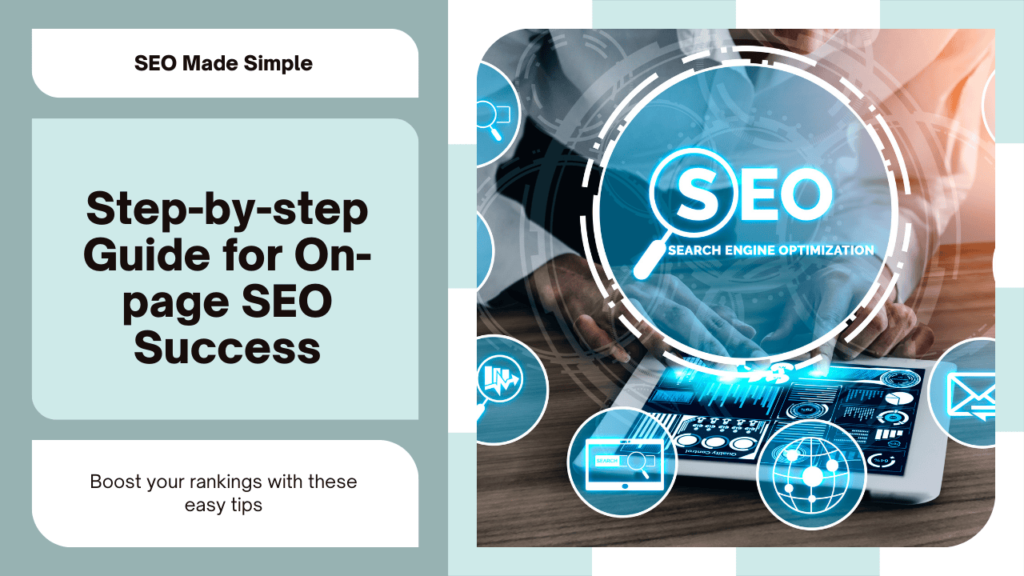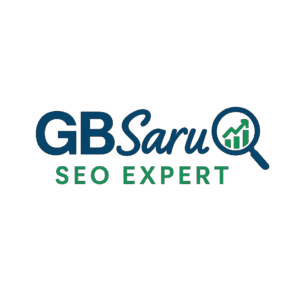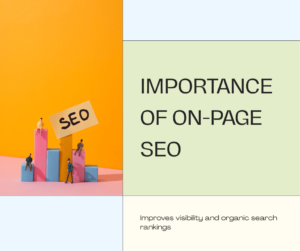What is On-Page SEO?
On-Page SEO is the process of optimizing individual web pages on your website to rank higher in search engine results and attract more relevant traffic. It focuses on elements within your website, like content, HTML structure, and user experience, to make your pages more visible to search engines like Google.
 Imagine your webpage as a storefront. On-page SEO is all about:
Imagine your webpage as a storefront. On-page SEO is all about:- Setting up an eye-catching display (your content).
- Make it easy for customers (or search engines) to navigate your store.
- Convincing them that your products (or information) are exactly what they’re looking for.
Why is On-Page SEO Important?
1. Improves Rankings:
It helps your webpage rank higher in search results, making it easier for people to find your content.
– For Example: If someone searches for “best gardening tips,” your page is more likely to show up if it’s optimized.
Improving On-Page SEO is critical, but it’s just one part of learning how to master the art of SEO and improve your overall website visibility.
2. Attracts Relevant Traffic:
By targeting the right keywords, you attract users who are genuinely interested in your topic or product.
3. Enhances User Experience:
A well-structured, easy-to-read webpage keeps visitors happy, increasing the chance they’ll stay longer.
4. Boosts Credibility:
Search engines prefer websites with relevant, high-quality content, so proper on-page SEO builds trust.
Step-by-Step Guide to On-Page SEO


1. Choose Relevant Keywords
– Research what people are searching for using tools like Google Keyword Planner or SEMrush.
– Example: If your topic is about “gardening tips”, your keywords could be:
– Primary Keyword: “gardening tips for beginners”
– Secondary Keywords: “how to start gardening”, *easy gardening hacks*
2. Write a Compelling Title (Title Tag)
– This is the main clickable headline that appears in search results.
– Example: “10 Easy Gardening Tips for Beginners to Start Today”
(Primary keyword included, under 60 characters, and enticing.)
3. Optimize Meta Description
– This is the short blurb under your title in search results.
– Example: “Learn 10 simple gardening tips for beginners to grow your first garden. Perfect for first-timers!”
4. Structure Your Content
– Use headings (H1 for the main title, H2 and H3 for subheadings) to organize your content.
– Example Structure:
– H1: Gardening Tips for Beginners
– H2: Choosing the Right Tools
– H2: Starting with Easy Plants
– H3: Why Herbs Are Great for Starters
5. Place Keywords Strategically
– Add your primary keyword in the first 100 words, headings, and naturally throughout the text.
Including on-page SEO ranking factors like proper keyword placement ensures better optimization.
– Example: “Gardening tips for beginners don’t have to be complicated. Start with these 10 easy steps to grow your garden.”
6. Create High-Quality Content
– Write engaging, clear content that provides real value.
– Example: List actionable tips like:
– Start small with herbs like basil or mint.
– Use compost to improve soil health.
– Water early in the morning to prevent evaporation.
7. Add Images with Alt Text
– Use images to make your content visually appealing, and describe them with alt text (helps search engines “see” your images).
– Example:
– Image: A small herb garden.
– Alt Text: “Herbs in pots for a beginner garden setup.”
8. Use SEO-Friendly URL
– Keep URLs short and descriptive.
– Example: yourwebsite.com/gardening-tips-beginners
9. Include Internal and External Links
– Internal Links:
Link to other pages on your site.
– Example: “Check out our guide to the top 5 gardening tools for beginners.”
– External Links:
Link to credible sources.
– Example: “According to this [study on organic gardening](external-link), compost improves plant growth.”
10. Improve Page Speed and Mobile-Friendliness
– Compress images and use a mobile-friendly design.
– Test your page speed using tools like Google PageSpeed Insights.
11. Add a Call-to-Action (CTA)
– Encourage readers to take the next step. Want to learn more about SEO and its professionals? Click here to dive into what experts do behind the scenes.
– Example: “Ready to grow your own garden? Download our free checklist!”
12. Analyze and Update
– Use tools like Google Analytics to track how your page is performing.
– Update content regularly to stay relevant.
– Example: Add new trends like “vertical gardening tips” to keep the content fresh.
CONCLUSIONS
On-page SEO is about making your webpage the best it can be—for both users and search engines. By using relevant keywords, organizing your content, and ensuring a great user experience, you increase your chances of attracting more visitors.


